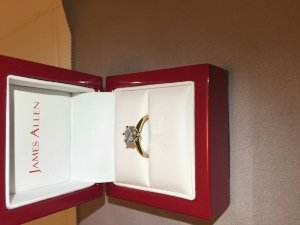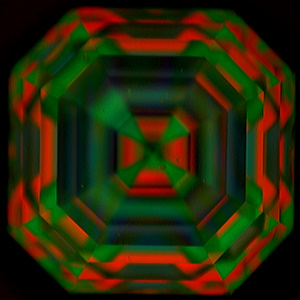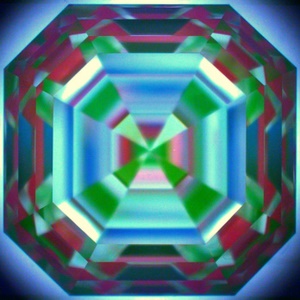Hey everyone! Would appreciate your feedback on this asscher that I'm looking at. Thanks a bunch!

Shape: Asscher
Carat weight: 3.08
Cut: Ideal
Color: I
Clarity: IF
Certificate: GIA
Depth: 67.6%
Table: 65.0%
Polish: Excellent
Symmetry: Excellent
Girdle: Slightly thick to thick
Culet: None
Fluorescence: Faint
Measurements: 7.98*7.97*5.39
Ratio: 1.00
ASET images:


Below is a note from the gemologist.
The ASET camera system was developed by AGS several years back as a method of determining the different types of light return/reflection in a diamond. The ASET camera system is based on the simple idea that as light travels towards a diamond, the direction of that light can be captured and recorded by a filter (or cone) placed above the diamond and painted (or colored) into different horizontal sections.
The bottom section of the filter is colored GREEN and represents light that comes from the horizontal plane. This light is often called "INDIRECT LIGHT" and so any GREEN in the diamond image is good and represents that indirect light being reflected back to the camera. The middle section of the filter is colored RED and represents light that comes from the most common angles (such as lights in a ceiling, the sun, etc). This light is referred to as DIRECT LIGHT. Since direct light is most common in real-life viewing environments, we hope to see lots of RED in the captured ASET image. The more RED, the better job the diamond is doing at reflecting light from its primary light sources. The top section of the filter is colored BLUE and represents light that is often blocked by the viewers head/body. This light is generally referred to as OBSTRUCTED. Obstructed light is important for creating contrast in a diamond and is what makes the arrows "pop" in a Hearts & Arrows diamond. Seeing BLUE in an ASET image is also good, although there should not be too much of it.
Lastly, the camera can capture areas in the diamond where light is "leaking", or not being reflected back to the viewer. In the ASET camera developed by AGS, this leakage is shown as BLACK. In other ASET camera setups, this leakage can appear as WHITE.
With all of that said, you'll find the requested ASET images. Our gemologist found this diamond to have a high I color performance but noted that it faces much smaller than you would expect. Due to this diamond being very bottom heavy, it faces about as large as a 1.75 to 2 carat diamond. You'll also see in the attached ASET images that this diamond is slightly dark under the table.

Shape: Asscher
Carat weight: 3.08
Cut: Ideal
Color: I
Clarity: IF
Certificate: GIA
Depth: 67.6%
Table: 65.0%
Polish: Excellent
Symmetry: Excellent
Girdle: Slightly thick to thick
Culet: None
Fluorescence: Faint
Measurements: 7.98*7.97*5.39
Ratio: 1.00
ASET images:


Below is a note from the gemologist.
The ASET camera system was developed by AGS several years back as a method of determining the different types of light return/reflection in a diamond. The ASET camera system is based on the simple idea that as light travels towards a diamond, the direction of that light can be captured and recorded by a filter (or cone) placed above the diamond and painted (or colored) into different horizontal sections.
The bottom section of the filter is colored GREEN and represents light that comes from the horizontal plane. This light is often called "INDIRECT LIGHT" and so any GREEN in the diamond image is good and represents that indirect light being reflected back to the camera. The middle section of the filter is colored RED and represents light that comes from the most common angles (such as lights in a ceiling, the sun, etc). This light is referred to as DIRECT LIGHT. Since direct light is most common in real-life viewing environments, we hope to see lots of RED in the captured ASET image. The more RED, the better job the diamond is doing at reflecting light from its primary light sources. The top section of the filter is colored BLUE and represents light that is often blocked by the viewers head/body. This light is generally referred to as OBSTRUCTED. Obstructed light is important for creating contrast in a diamond and is what makes the arrows "pop" in a Hearts & Arrows diamond. Seeing BLUE in an ASET image is also good, although there should not be too much of it.
Lastly, the camera can capture areas in the diamond where light is "leaking", or not being reflected back to the viewer. In the ASET camera developed by AGS, this leakage is shown as BLACK. In other ASET camera setups, this leakage can appear as WHITE.
With all of that said, you'll find the requested ASET images. Our gemologist found this diamond to have a high I color performance but noted that it faces much smaller than you would expect. Due to this diamond being very bottom heavy, it faces about as large as a 1.75 to 2 carat diamond. You'll also see in the attached ASET images that this diamond is slightly dark under the table.



300x240.png)